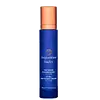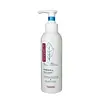What's inside
What's inside
 Key Ingredients
Key Ingredients

 Benefits
Benefits

 Concerns
Concerns

 Ingredients Side-by-side
Ingredients Side-by-side

Water
Skin ConditioningGlycerin
HumectantPrunus Amygdalus Dulcis Oil
Skin ConditioningRosa Damascena Flower Water
MaskingDisodium Cocoyl Glutamate
CleansingCoco-Glucoside
CleansingXanthan Gum
Emulsifying1,2-Hexanediol
Skin ConditioningCitric Acid
BufferingSodium Chloride
MaskingCarrageenan
Coconut Acid
CleansingO-Cymen-5-Ol
AntimicrobialCucumis Sativus Fruit Extract
EmollientHelianthus Annuus Seed Oil
EmollientTocopherol
AntioxidantHydrolyzed Rice Protein
Skin ConditioningMaltodextrin
AbsorbentAloe Barbadensis Leaf Juice Powder
Skin ConditioningCamellia Sinensis Leaf Extract
AntimicrobialHydrogenated Lecithin
EmulsifyingTocopheryl Acetate
AntioxidantAlanyl Glutamine
HumectantArginine
MaskingOligopeptide-177
Phenylalanine
MaskingPotassium Sorbate
PreservativeSisymbrium Irio Seed Oil
MaskingWater, Glycerin, Prunus Amygdalus Dulcis Oil, Rosa Damascena Flower Water, Disodium Cocoyl Glutamate, Coco-Glucoside, Xanthan Gum, 1,2-Hexanediol, Citric Acid, Sodium Chloride, Carrageenan, Coconut Acid, O-Cymen-5-Ol, Cucumis Sativus Fruit Extract, Helianthus Annuus Seed Oil, Tocopherol, Hydrolyzed Rice Protein, Maltodextrin, Aloe Barbadensis Leaf Juice Powder, Camellia Sinensis Leaf Extract, Hydrogenated Lecithin, Tocopheryl Acetate, Alanyl Glutamine, Arginine, Oligopeptide-177, Phenylalanine, Potassium Sorbate, Sisymbrium Irio Seed Oil
1,2-Hexanediol
Skin ConditioningWater
Skin ConditioningBisabolol
MaskingButyl Avocadate
Skin ConditioningCapryloyl Glycine
CleansingCetearyl Alcohol
EmollientCI 77891
Cosmetic ColorantCitric Acid
BufferingCoco-Glucoside
CleansingDisodium Cocoyl Glutamate
CleansingDisodium Lauryl Sulfosuccinate
CleansingGlycerin
HumectantGlyceryl Caprylate
EmollientGlycine Soja Oil
EmollientGlycine Soja Sterols
EmollientGlycolipids
Skin ConditioningHydrogenated Castor Oil
EmollientHydrolyzed Chenopodium Quinoa Seed
Skin ConditioningHydroxypropyl Guar
Emulsion StabilisingMaltodextrin
AbsorbentParfum
MaskingPhospholipids
Skin ConditioningPotassium Sorbate
PreservativeSodium Chloride
MaskingSodium Cocoyl Glutamate
CleansingSodium Cocoyl Isethionate
CleansingTocopherol
AntioxidantZea Mays Starch
AbsorbentZinc Gluconate
Skin Conditioning1,2-Hexanediol, Water, Bisabolol, Butyl Avocadate, Capryloyl Glycine, Cetearyl Alcohol, CI 77891, Citric Acid, Coco-Glucoside, Disodium Cocoyl Glutamate, Disodium Lauryl Sulfosuccinate, Glycerin, Glyceryl Caprylate, Glycine Soja Oil, Glycine Soja Sterols, Glycolipids, Hydrogenated Castor Oil, Hydrolyzed Chenopodium Quinoa Seed, Hydroxypropyl Guar, Maltodextrin, Parfum, Phospholipids, Potassium Sorbate, Sodium Chloride, Sodium Cocoyl Glutamate, Sodium Cocoyl Isethionate, Tocopherol, Zea Mays Starch, Zinc Gluconate
 Reviews
Reviews

Ingredients Explained
These ingredients are found in both products.
Ingredients higher up in an ingredient list are typically present in a larger amount.
1,2-Hexanediol is a synthetic liquid and another multi-functional powerhouse.
It is a:
- Humectant, drawing moisture into the skin
- Emollient, helping to soften skin
- Solvent, dispersing and stabilizing formulas
- Preservative booster, enhancing the antimicrobial activity of other preservatives
Citric Acid is an alpha hydroxy acid (AHA) naturally found in citrus fruits like oranges, lemons, and limes.
Like other AHAs, citric acid can exfoliate skin by breaking down the bonds that hold dead skin cells together. This helps reveal smoother and brighter skin underneath.
However, this exfoliating effect only happens at high concentrations (20%) which can be hard to find in cosmetic products.
Due to this, citric acid is usually included in small amounts as a pH adjuster. This helps keep products slightly more acidic and compatible with skin's natural pH.
In skincare formulas, citric acid can:
While it can provide some skin benefits, research shows lactic acid and glycolic acid are generally more effective and less irritating exfoliants.
Most citric acid used in skincare today is made by fermenting sugars (usually from molasses). This synthetic version is identical to the natural citrus form but easier to stabilize and use in formulations.
Read more about some other popular AHA's here:
Learn more about Citric AcidCoco-Glucoside is a surfactant, or a cleansing ingredient. It is made from glucose and coconut oil.
Surfactants help gather dirt, oil, and other pollutants from your skin to be rinsed away.
This ingredient is considered gentle and non-comedogenic. However, it may still be irritating for some.
Learn more about Coco-GlucosideWe don't have a description for Disodium Cocoyl Glutamate yet.
Glycerin is already naturally found in your skin. It helps moisturize and protect your skin.
A study from 2016 found glycerin to be more effective as a humectant than AHAs and hyaluronic acid.
As a humectant, it helps the skin stay hydrated by pulling moisture to your skin. The low molecular weight of glycerin allows it to pull moisture into the deeper layers of your skin.
Hydrated skin improves your skin barrier; Your skin barrier helps protect against irritants and bacteria.
Glycerin has also been found to have antimicrobial and antiviral properties. Due to these properties, glycerin is often used in wound and burn treatments.
In cosmetics, glycerin is usually derived from plants such as soybean or palm. However, it can also be sourced from animals, such as tallow or animal fat.
This ingredient is organic, colorless, odorless, and non-toxic.
Glycerin is the name for this ingredient in American English. British English uses Glycerol/Glycerine.
Learn more about GlycerinMaltodextrin is a polysaccharide. It is derived from starch such as rice, corn, wheat, or potato starch.
In food, Maltodextrin is used to improve the texture and thicken a product. Due to its structure, it can help create a gel texture. As an emulsion stabilizer, it helps keep the ingredients in a product together.
As a polysaccharide, Maltodextrin has moisturizing properties. Polysaccharides are a type of carbohydrate. The top layer of skin uses polysaccharides to retain water, keeping the skin hydrated.
Maltodextrin is water soluble and has a sweet taste.
Learn more about MaltodextrinPotassium Sorbate is a preservative used to prevent yeast and mold in products. It is commonly found in both cosmetic and food products.
This ingredient comes from potassium salt derived from sorbic acid. Sorbic acid is a natural antibiotic and effective against fungus.
Both potassium sorbate and sorbic acid can be found in baked goods, cheeses, dried meats, dried fruit, ice cream, pickles, wine, yogurt, and more.
You'll often find this ingredient used with other preservatives.
Learn more about Potassium SorbateChances are, you eat sodium chloride every day. Sodium Chloride is also known as table salt.
This ingredient has many purposes in skincare: thickener, emulsifier, and exfoliator.
You'll most likely find this ingredient in cleansers where it is used to create a gel-like texture. As an emulsifier, it also prevents ingredients from separating.
There is much debate on whether this ingredient is comedogenic. The short answer - comedogenic ratings don't tell the whole story. Learn more about comegodenic ratings here.
The concensus about this ingredient causing acne seems to be divided. Research is needed to understand if this ingredient does cause acne.
Scrubs may use salt as the primary exfoliating ingredient.
Learn more about Sodium ChlorideTocopherol (also known as Vitamin E) is a common antioxidant used to help protect the skin from free-radicals and strengthen the skin barrier. It's also fat soluble - this means our skin is great at absorbing it.
Vitamin E also helps keep your natural skin lipids healthy. Your lipid skin barrier naturally consists of lipids, ceramides, and fatty acids. Vitamin E offers extra protection for your skin’s lipid barrier, keeping your skin healthy and nourished.
Another benefit is a bit of UV protection. Vitamin E helps reduce the damage caused by UVB rays. (It should not replace your sunscreen). Combining it with Vitamin C can decrease sunburned cells and hyperpigmentation after UV exposure.
You might have noticed Vitamin E + C often paired together. This is because it is great at stabilizing Vitamin C. Using the two together helps increase the effectiveness of both ingredients.
There are often claims that Vitamin E can reduce/prevent scarring, but these claims haven't been confirmed by scientific research.
Learn more about TocopherolWater. It's the most common cosmetic ingredient of all. You'll usually see it at the top of ingredient lists, meaning that it makes up the largest part of the product.
So why is it so popular? Water most often acts as a solvent - this means that it helps dissolve other ingredients into the formulation.
You'll also recognize water as that liquid we all need to stay alive. If you see this, drink a glass of water. Stay hydrated!
Learn more about Water